1. Mills KT, Bundy JD, Kelly TN, Reed JE, Kearney PM, Reynolds K, Chen J, He J. Global disparities of hypertension prevalence and control: a systematic analysis of population-based studies from 90 countries. Circulation. 2016; 134:441–450. PMID:
27502908.
2. Lawes CM, Vander Hoorn S, Rodgers A. International Society of Hypertension. Global burden of blood-pressure-related disease, 2001. Lancet. 2008; 371:1513–1518. PMID:
18456100.

3. Kearney PM, Whelton M, Reynolds K, Muntner P, Whelton PK, He J. Global burden of hypertension: analysis of worldwide data. Lancet. 2005; 365:217–223. PMID:
15652604.

4. Mittal BV, Singh AK. Hypertension in the developing world: challenges and opportunities. Am J Kidney Dis. 2010; 55:590–598. PMID:
19962803.

5. Benjamin EJ, Blaha MJ, Chiuve SE, Cushman M, Das SR, Deo R, de Ferranti SD, Floyd J, Fornage M, Gillespie C, et al. Heart disease and stroke statistics-2017 update: a report from the American Heart Association. Circulation. 2017; 135:e146–e603. PMID:
28122885.

6. Mozaffarian D, Benjamin EJ, Go AS, Arnett DK, Blaha MJ, Cushman M, de Ferranti S, Després JP, Fullerton HJ, Howard VJ, et al. Heart disease and stroke statistics--2015 update: a report from the American Heart Association. Circulation. 2015; 131:e29–322. PMID:
25520374.
7. Arnett DK, Blumenthal RS, Albert MA, Buroker AB, Goldberger ZD, Hahn EJ, Himmelfarb CD, Khera A, Lloyd-Jones D, McEvoy JW, et al. 2019 ACC/AHA Guideline on the primary prevention of cardiovascular disease: executive summary: a report of the American College of Cardiology/American Heart Association Task Force on Clinical Practice Guidelines. Circulation. 2019; 140:e563–e595. PMID:
30879339.

8. Zhang GH, Ma JX, Guo XL, Dong J, Chen X, Zhang JY, Su JY, Tang JL, Xu AQ. Field observation on the effect of low-sodium and high-potassium salt substitute on blood pressure in the rural community-based population in China. Zhonghua Liu Xing Bing Xue Za Zhi. 2011; 32:859–863. PMID:
22340870.
9. Yang Q, Liu T, Kuklina EV, Flanders WD, Hong Y, Gillespie C, Chang MH, Gwinn M, Dowling N, Khoury MJ, et al. Sodium and potassium intake and mortality among US adults: prospective data from the Third National Health and Nutrition Examination Survey. Arch Intern Med. 2011; 171:1183–1191. PMID:
21747015.
10. Bailey RL, Parker EA, Rhodes DG, Goldman JD, Clemens JC, Moshfegh AJ, Thuppal SV, Weaver CM. Estimating sodium and potassium intakes and their ratio in the American diet: data from the 2011–2012 NHANES. J Nutr. 2016; 146:745–750.

11. Adrogué HJ, Madias NE. Sodium and potassium in the pathogenesis of hypertension. N Engl J Med. 2007; 356:1966–1978. PMID:
17494929.

12. Ford ES, Li C, McGuire LC, Mokdad AH, Liu S. Intake of dietary magnesium and the prevalence of the metabolic syndrome among U.S. adults. Obesity (Silver Spring). 2007; 15:1139–1146. PMID:
17495189.

13. Park J, Lee JS, Kim J. Relationship between dietary sodium, potassium, and calcium, anthropometric indexes, and blood pressure in young and middle aged Korean adults. Nutr Res Pract. 2010; 4:155–162. PMID:
20461205.

14. Beydoun MA, Gary TL, Caballero BH, Lawrence RS, Cheskin LJ, Wang Y. Ethnic differences in dairy and related nutrient consumption among US adults and their association with obesity, central obesity, and the metabolic syndrome. Am J Clin Nutr. 2008; 87:1914–1925. PMID:
18541585.

15. Cormick G, Ciapponi A, Cafferata ML, Belizán JM. Calcium supplementation for prevention of primary hypertension. Cochrane Database Syst Rev. 2015; (6):CD010037. PMID:
26126003.

16. Kim MH, Bu SY, Choi MK. Daily calcium intake and its relation to blood pressure, blood lipids, and oxidative stress biomarkers in hypertensive and normotensive subjects. Nutr Res Pract. 2012; 6:421–428. PMID:
23198021.

17. Liu S, Song Y, Ford ES, Manson JE, Buring JE, Ridker PM. Dietary calcium, vitamin D, and the prevalence of metabolic syndrome in middle-aged and older U.S. women. Diabetes Care. 2005; 28:2926–2932. PMID:
16306556.

18. Sacks FM, Svetkey LP, Vollmer WM, Appel LJ, Bray GA, Harsha D, Obarzanek E, Conlin PR, Miller ER 3rd, Simons-Morton DG, et al. Effects on blood pressure of reduced dietary sodium and the dietary approaches to stop hypertension (DASH) diet. N Engl J Med. 2001; 344:3–10. PMID:
11136953.

19. Aburto NJ, Hanson S, Gutierrez H, Hooper L, Elliott P, Cappuccio FP. Effect of increased potassium intake on cardiovascular risk factors and disease: systematic review and meta-analyses. BMJ. 2013; 346:f1378. PMID:
23558164.

20. Seligman HK, Laraia BA, Kushel MB. Food insecurity is associated with chronic disease among low-income NHANES participants. J Nutr. 2010; 140:304–310. PMID:
20032485.

21. Nielsen FH. Magnesium, inflammation, and obesity in chronic disease. Nutr Rev. 2010; 68:333–340. PMID:
20536778.

22. Rayssiguier Y, Libako P, Nowacki W, Rock E. Magnesium deficiency and metabolic syndrome: stress and inflammation may reflect calcium activation. Magnes Res. 2010; 23:73–80. PMID:
20513641.
23. Parker JD, Kruszon-Moran D, Mohadjer LK, Dohrmann SM, Van de Kerckhove W, Clark J, Burt VL. National Health and Nutrition Examination Survey: California and Los Angeles County, estimation methods and analytic considerations, 1999–2006 and 2007–2014. Vital Health Stat 2. 2017; 1–26.
24. Centers for Disease Control and Prevention (CDC). Vital signs: prevalence, treatment, and control of hypertension--United States, 1999–2002 and 2005–2008. MMWR Morb Mortal Wkly Rep. 2011; 60:103–108. PMID:
21293325.
26. Hite AH. The 2015 dietary guidelines for Americans: irrelevant or alarming? or both? J Evol Health. 2017; 2:14.

27. Xu J, Chen X, Ge Z, Liang H, Yan L, Guo X, Zhang Y, Wang L, Ma J. Associations of usual 24-hour sodium and potassium intakes with blood pressure and risk of hypertension among adults in China's Shandong and Jiangsu Provinces. Kidney Blood Press Res. 2017; 42:188–200. PMID:
28494444.

28. Whelton PK, He J, Cutler JA, Brancati FL, Appel LJ, Follmann D, Klag MJ. Effects of oral potassium on blood pressure. Meta-analysis of randomized controlled clinical trials. JAMA. 1997; 277:1624–1632. PMID:
9168293.
29. Poorolajal J, Zeraati F, Soltanian AR, Sheikh V, Hooshmand E, Maleki A. Oral potassium supplementation for management of essential hypertension: a meta-analysis of randomized controlled trials. PLoS One. 2017; 12:e0174967. PMID:
28419159.

30. Khaw KT, Barrett-Connor E. The association between blood pressure, age, and dietary sodium and potassium: a population study. Circulation. 1988; 77:53–61. PMID:
3257173.

31. Martin TP, Fischer AN. Sodium, potassium, and high blood pressure. ACSMs Health Fit J. 2012; 16:13–21.

32. Binia A, Jaeger J, Hu Y, Singh A, Zimmermann D. Daily potassium intake and sodium-to-potassium ratio in the reduction of blood pressure: a meta-analysis of randomized controlled trials. J Hypertens. 2015; 33:1509–1520. PMID:
26039623.
33. Young DB. Role of Potassium in Preventive Cardiovascular Medicine. Berlin: Springer Science & Business Media;2012.
34. Khaw KT, Barrett-Connor E. The association between blood pressure, age, and dietary sodium and potassium: a population study. Circulation. 1988; 77:53–61. PMID:
3257173.

35. Spahn JM, Lyon JM, Altman JM, Blum-Kemelor DM, Essery EV, Fungwe TV, Macneil PC, McGrane MM, Obbagy JE, Wong YP. The systematic review methodology used to support the 2010 Dietary Guidelines Advisory Committee. J Am Diet Assoc. 2011; 111:520–523. PMID:
21443982.

36. Faulkner JL, Harwood D, Bender L, Shrestha L, Brands MW, Morwitzer MJ, Kennard S, Antonova G, Belin de Chantemèle EJ. Lack of suppression of aldosterone production leads to salt-sensitive hypertension in female but not male Balb/C mice. Hypertension. 2018; 72:1397–1406. PMID:
30571230.

37. Spahn JM, Lyon JM, Altman JM, Blum-Kemelor DM, Essery EV, Fungwe TV, Macneil PC, McGrane MM, Obbagy JE, Wong YP. The systematic review methodology used to support the 2010 Dietary Guidelines Advisory Committee. J Am Diet Assoc. 2011; 111:520–523. PMID:
21443982.

38. Pilic L, Pedlar CR, Mavrommatis Y. Salt-sensitive hypertension: mechanisms and effects of dietary and other lifestyle factors. Nutr Rev. 2016; 74:645–658. PMID:
27566757.

39. Weaver CM, Bailey RL, McCabe LD, Moshfegh AJ, Rhodes DG, Goldman JD, Lobene AJ, McCabe GP. Mineral intake ratios are a weak but significant factor in blood pressure variability in US adults. J Nutr. 2018; 148:1845–1851. PMID:
30383279.

40. Sharma S, McFann K, Chonchol M, Kendrick J. Dietary sodium and potassium intake is not associated with elevated blood pressure in US adults with no prior history of hypertension. J Clin Hypertens (Greenwich). 2014; 16:418–423. PMID:
24720647.

41. Chmielewski J, Carmody JB. Dietary sodium, dietary potassium, and systolic blood pressure in US adolescents. J Clin Hypertens (Greenwich). 2017; 19:904–909. PMID:
28485063.

42. Liu Y, Shi M, Dolan J, He J. Sodium sensitivity of blood pressure in Chinese populations. J Hum Hypertens. 2020; 34:94–107. PMID:
30631129.

43. Huan Y, Deloach S, Keith SW, Goodfriend TL, Falkner B. Aldosterone and aldosterone: renin ratio associations with insulin resistance and blood pressure in African Americans. J Am Soc Hypertens. 2012; 6:56–65. PMID:
22024666.

44. He FJ, Markandu ND, Sagnella GA, MacGregor GA. Importance of the renin system in determining blood pressure fall with salt restriction in black and white hypertensives. Hypertension. 1998; 32:820–824. PMID:
9822438.

45. Ferrario CM. Role of angiotensin II in cardiovascular disease therapeutic implications of more than a century of research. J Renin Angiotensin Aldosterone Syst. 2006; 7:3–14. PMID:
17083068.
46. Scuteri A, Stuehlinger MC, Cooke JP, Wright JG, Lakatta EG, Anderson DE, Fleg JL. Nitric oxide inhibition as a mechanism for blood pressure increase during salt loading in normotensive postmenopausal women. J Hypertens. 2003; 21:1339–1346. PMID:
12817182.

47. Wright JT Jr, Rahman M, Scarpa A, Fatholahi M, Griffin V, Jean-Baptiste R, Islam M, Eissa M, White S, Douglas JG. Determinants of salt sensitivity in black and white normotensive and hypertensive women. Hypertension. 2003; 42:1087–1092. PMID:
14610097.

48. Moore-Schiltz L, Albert JM, Singer ME, Swain J, Nock NL. Dietary intake of calcium and magnesium and the metabolic syndrome in the National Health and Nutrition Examination (NHANES) 2001-2010 data. Br J Nutr. 2015; 114:924–935. PMID:
26259506.

49. Resnick LM. The role of dietary calcium in hypertension: a hierarchical overview. Am J Hypertens. 1999; 12:99–112. PMID:
10075395.
50. Bucher HC, Cook RJ, Guyatt GH, Lang JD, Cook DJ, Hatala R, Hunt DL. Effects of dietary calcium supplementation on blood pressure. A meta-analysis of randomized controlled trials. JAMA. 1996; 275:1016–1022. PMID:
8596234.
51. Chan Q, Stamler J, Griep LM, Daviglus ML, Horn LV, Elliott P. An update on nutrients and blood pressure. J Atheroscler Thromb. 2016; 23:276–289. PMID:
26686565.

52. McCarron DA, Reusser ME. Finding consensus in the dietary calcium-blood pressure debate. J Am Coll Nutr. 1999; 18(Suppl):398S–405S. PMID:
10511320.

53. Houston M. The role of magnesium in hypertension and cardiovascular disease. J Clin Hypertens (Greenwich). 2011; 13:843–847. PMID:
22051430.

54. Young DB, Lin H, McCabe RD. Potassium's cardiovascular protective mechanisms. Am J Physiol. 1995; 268:R825–R837. PMID:
7733391.

55. Intersalt Cooperative Research Group. Intersalt: an international study of electrolyte excretion and blood pressure. Results for 24 hour urinary sodium and potassium excretion. BMJ. 1988; 297:319–328. PMID:
3416162.
56. Bara M, Guiet-Bara A, Durlach J. Regulation of sodium and potassium pathways by magnesium in cell membranes. Magnes Res. 1993; 6:167–177. PMID:
8274363.
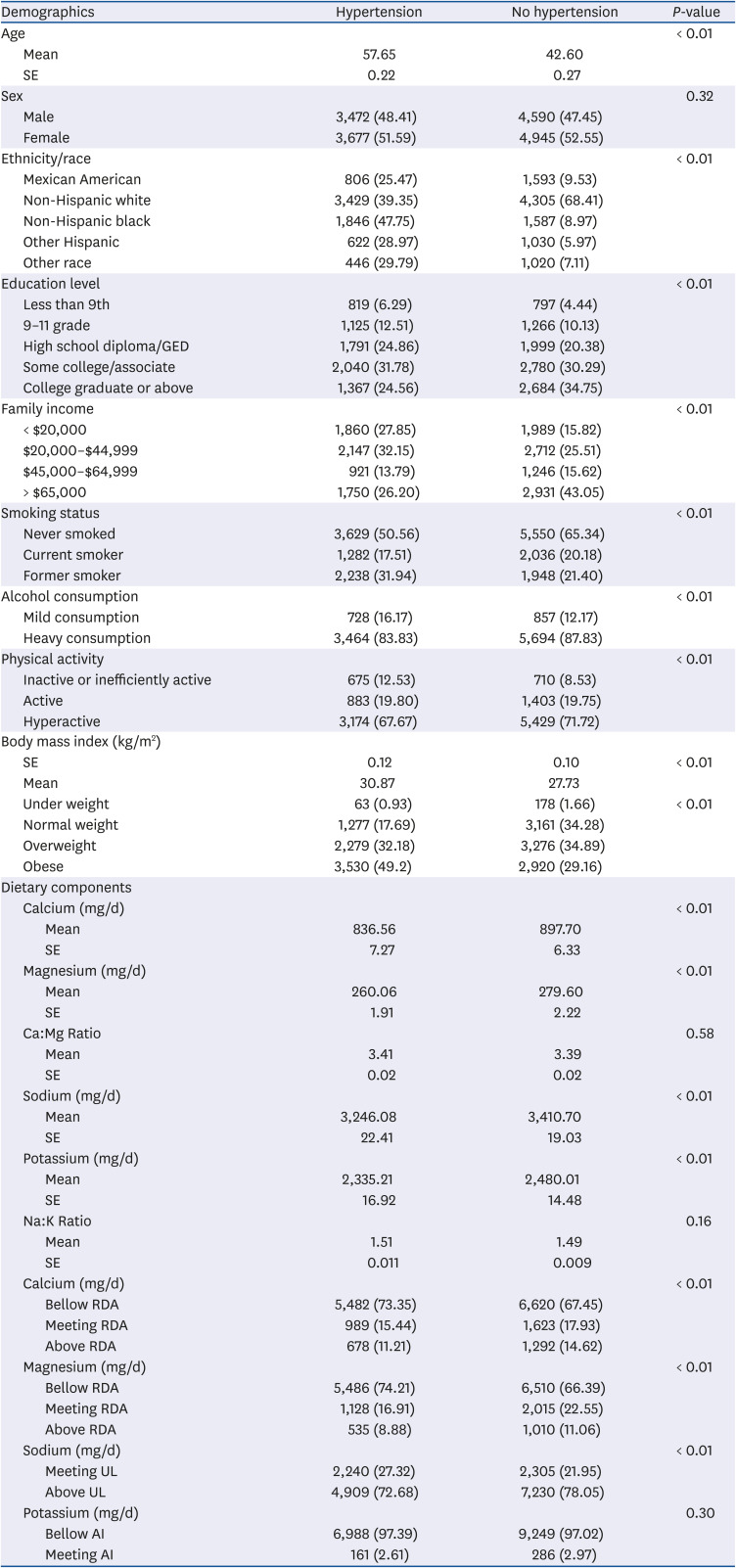
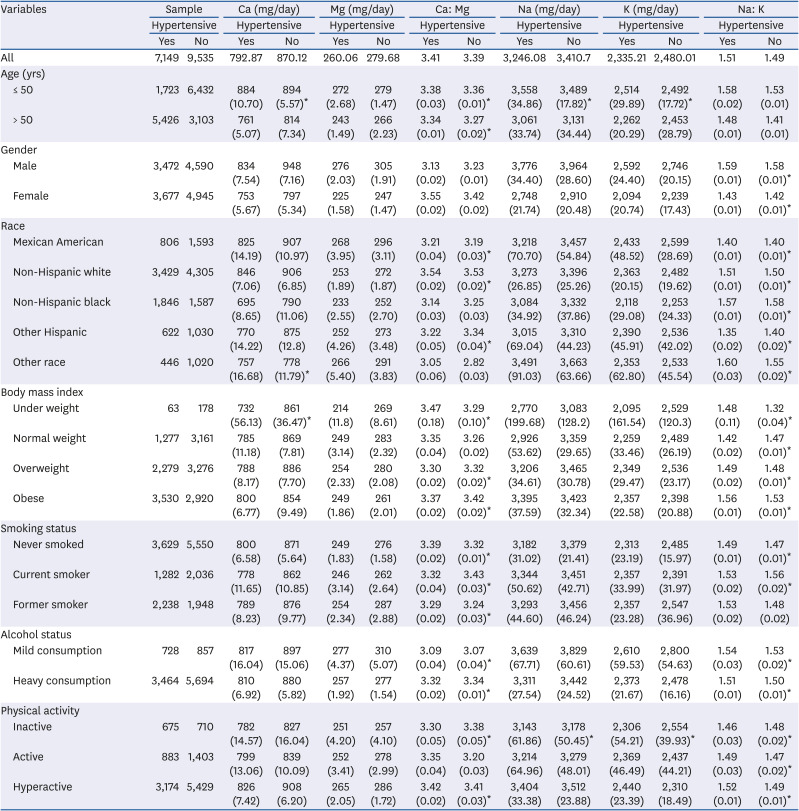

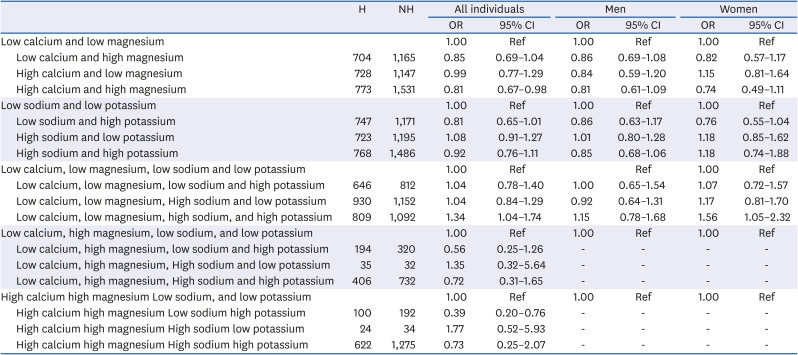
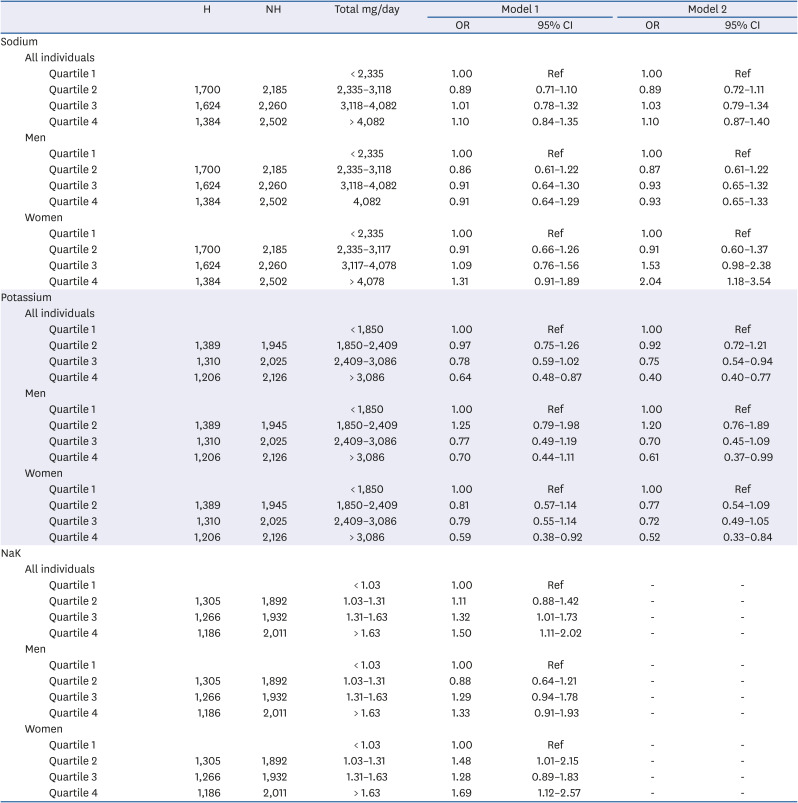
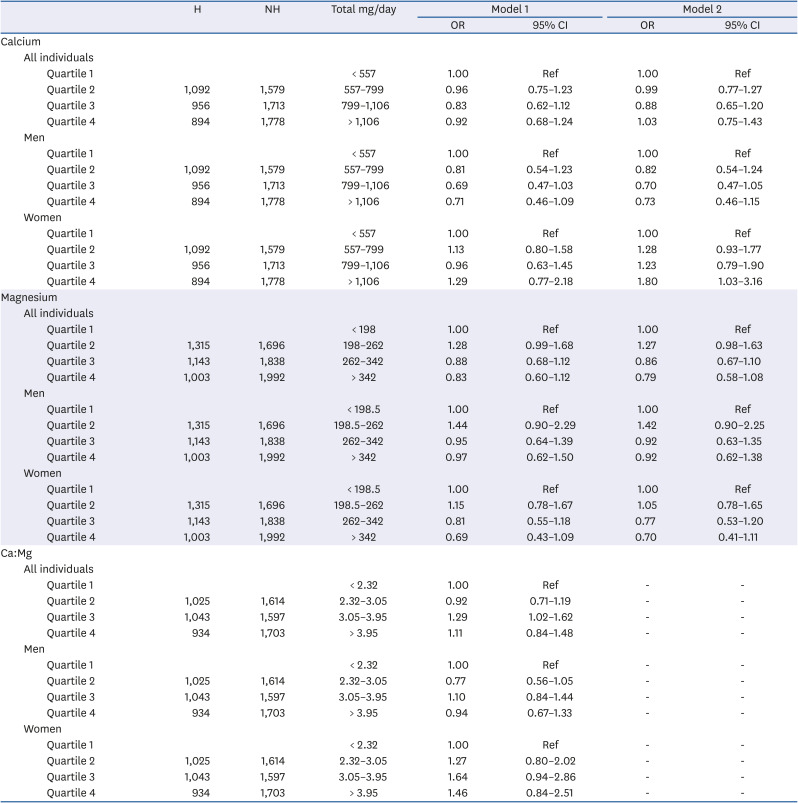
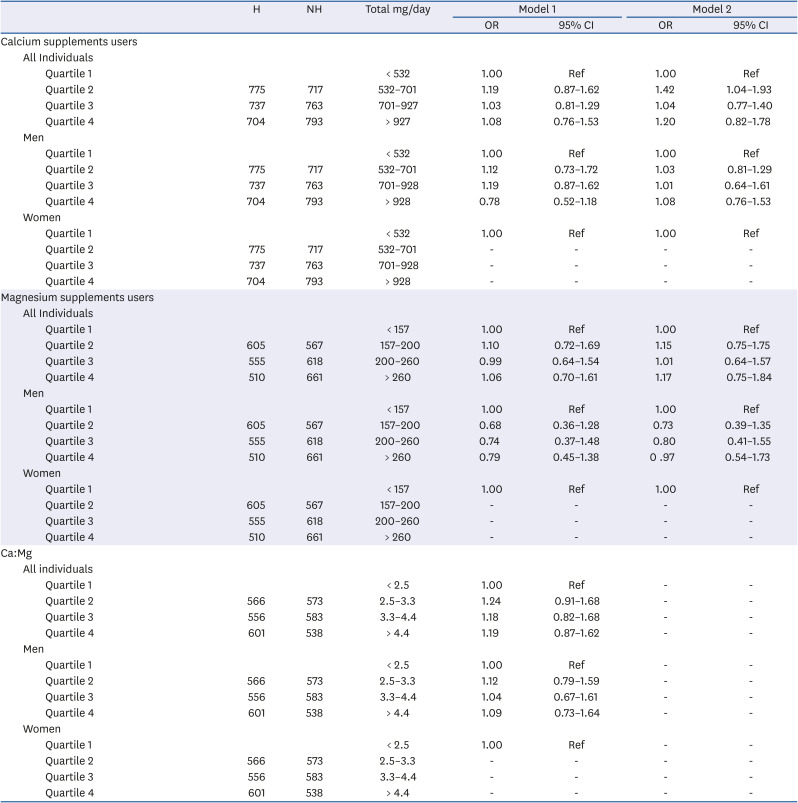




 PDF
PDF Citation
Citation Print
Print



 XML Download
XML Download